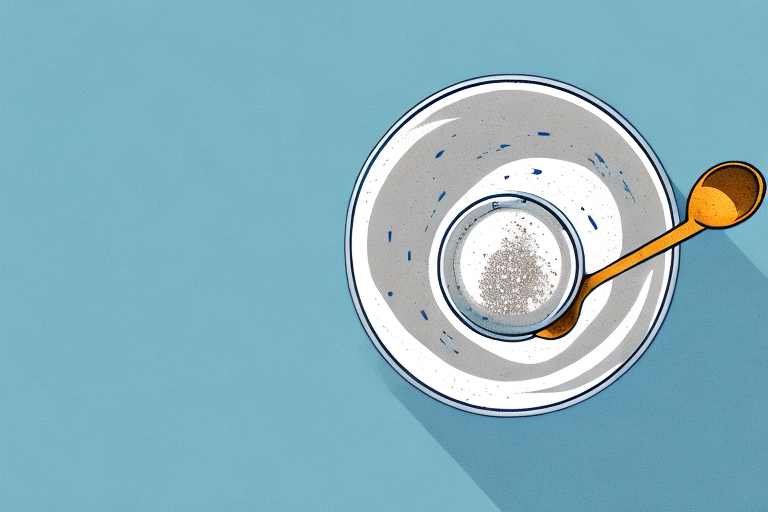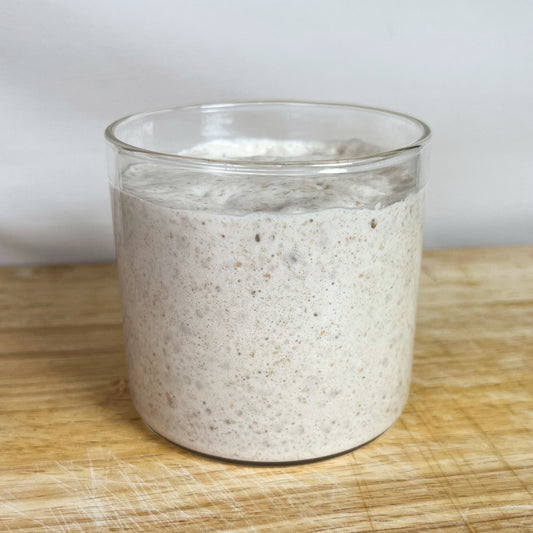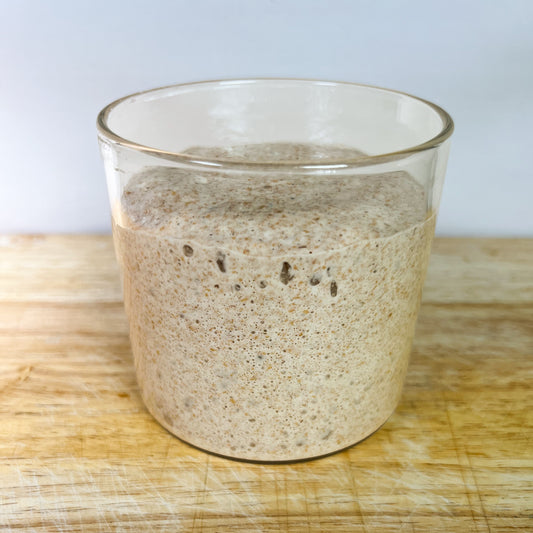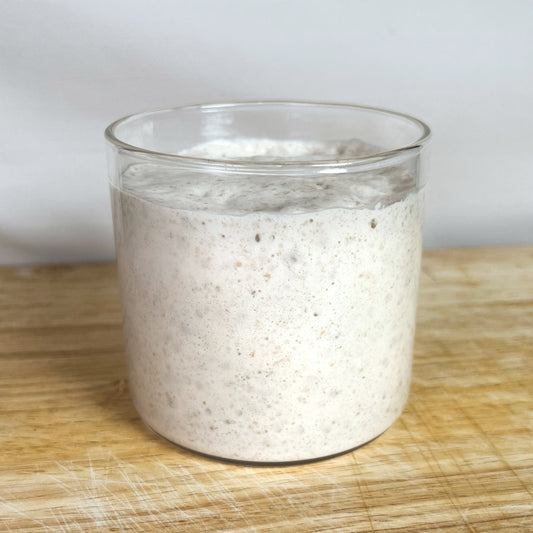The Sourdough Starter Journey: How to Buy, Care for, and Feed Your Sourdough Starter

Sourdough bread is more than just a tasty loaf – it's a journey. The process of making sourdough bread starts with a sourdough starter, a mix of flour and water that ferments naturally over time. This starter becomes the foundation for your bread, giving it a distinct, tangy flavor and natural rise. Here, we'll take you through everything you need to know about buying, caring for, and feeding your sourdough starter.
Understanding Sourdough Starters
Before you dive into the world of sourdough baking, it's important to understand what a sourdough starter is and why it's crucial for making great bread.
When it comes to baking bread, there are few things more rewarding than creating a beautiful, crusty, and flavorful loaf from scratch. And while there are many different methods for achieving this, one of the most popular and time-honored techniques is sourdough baking.
What is a Sourdough Starter?
At its core, a sourdough starter is a fermented mixture of water and flour that contains wild yeast and bacteria. This mixture always begins as a combination of flour and water that, when left to sit, begins to ferment. The fermentation process produces lactic acid and acetic acid, which are responsible for the sour tangy flavor that sourdough bread is known for.
Creating a sourdough starter is a simple process that requires only a few ingredients and some patience. All you need to do is mix together equal parts flour and water, cover the mixture, and let it sit at room temperature for several days. As the mixture ferments, it will begin to bubble and take on a slightly sour smell. This is a sign that the wild yeast and bacteria are doing their job.
The Role of Wild Yeast and Bacteria
The wild yeast and bacteria in a sourdough starter work together to create a natural leavening agent. The yeast feeds on the sugars in the flour, releasing carbon dioxide as a byproduct. This carbon dioxide gas is what causes the bread to rise, giving it its characteristic open crumb.
But the role of wild yeast and bacteria in sourdough baking goes beyond just leavening the bread. These microorganisms are also responsible for the unique flavor and texture of sourdough bread. Because the yeast and bacteria in a sourdough starter are specific to your environment, the flavor profile of your bread will be unique to your location.
Additionally, the longer fermentation time required for sourdough baking allows for more complex flavors to develop. This is because the bacteria in the starter break down the starches and proteins in the flour, creating a more flavorful and nutritious bread.
Buying Your Sourdough Starter
There are a few different routes you can take when it comes to acquiring a sourdough starter. Here's what you need to know:
Where to Purchase a Starter
You can find sourdough starters for sale in many places, from online retailers to local bakeries. Look for a reputable source that offers detailed instructions and support, as it's important to choose a starter that is suited to your environment and baking style.
If you're purchasing a starter online, be sure to read reviews and check the shipping details carefully. Sourdough starters are living organisms that require careful handling and temperature control during transit. You can buy sourdough starters in the UK from GetSourdough.
Local bakeries and specialty food stores may also sell sourdough starters. These can be a great option if you're looking for a more personal touch or want to support a small business.
Choosing the Right Starter for You
There are many types of sourdough starters available, each with its own unique flavour profile. Some starters are more suited to specific bread recipes or baking methods. Do some research to find a starter that aligns with your preferences and baking style.
Consider the flour used to create the starter, as well as the location and climate where the starter was developed. A starter that was created in a humid environment may behave differently than one developed in a dry climate.
If you have specific dietary requirements, such as a gluten-free diet, look for starters that are specifically formulated for those needs.
Store-bought vs. Homemade Starters
While it's certainly possible to make your own sourdough starter from scratch, many beginners prefer to start with a store-bought starter that has been already developed and stabilised. Homemade starters can be unpredictable and may require more maintenance and troubleshooting as you go.
However, making your own starter can be a rewarding and educational experience. It allows you to better understand the fermentation process and gives you more control over the final product.
If you do decide to make your own starter, be prepared for a bit of trial and error. It may take several attempts to get it right, but the end result is worth it.
Whether you choose to purchase a starter or make your own, remember that sourdough baking is a process that requires patience and practice. Don't be discouraged if your first few loaves don't turn out perfectly. With time and experience, you'll develop your own unique style and techniques.
Caring for Your Sourdough Starter
Once you have your starter, it's important to take care of it so that it remains healthy and active. Here are some tips:
The Importance of Temperature and Environment
Sourdough starters thrive in a warm, humid environment. If you bake every day or every other day try to keep your starter in a place that is consistently between 20-25°Cs and cover it with a damp cloth or lid to maintain humidity. Avoid placing the starter in direct sunlight or near drafts or drastic temperature changes.
If you don't bake daily, we recommend that you keep your starter in the fridge with a much lower hydration level. We have created a whole guide to storing and baking with your sourdough starter.
Check it out here: Guide to storing and baking with your sourdough starter.
It's also important to note that different types of flour can affect the temperature and environment of your starter. For example, whole wheat flour tends to ferment faster and produce more heat, while rye flour can make a starter more sluggish. Experiment with different flours to find the perfect balance for your starter.
Selecting the Best Container
When it comes to choosing a container for your starter, the most important factor is that it's non-reactive. Glass or ceramic containers are a great option, and avoid metal, plastic or anything else that might react with the fermented mixture. We ship all of our fresh sourdoughs starters in glass jars to ensure that you have the highest success rate.
Another factor to consider is the size of your container. A smaller container will require more frequent feedings, while a larger container may make it harder to maintain a consistent temperature and environment. A good rule of thumb is to choose a container that's at least twice the size of your starter.
Keeping Your Starter Clean and Healthy
To keep your starter healthy, it's important to feed it regularly and keep it clean. This means discarding a portion and adding fresh flour and water on a regular schedule. You should also observe your starter closely for any signs of mold or discolouration, which can indicate that it needs to be refreshed or discarded.
But what should you do with the discarded portion of your starter? Don't throw it away! There are plenty of delicious recipes that call for sourdough discard, such as pancakes, waffles, and even pizza crust. And if you don't want to use it right away, you can store it in the fridge or freezer for later use.
Final Thoughts
Caring for a sourdough starter can seem intimidating at first, but with a little practice and patience, it can become a rewarding and delicious hobby. Remember to experiment with different flours, containers, and feeding schedules to find what works best for you and your starter. And most importantly, have fun!
Feeding Your Sourdough Starter
Feeding your sourdough starter is what keeps it alive and healthy. Here's what you need to know:
The Basics of Feeding
Feeding your starter involves removing a portion of the mixture and replacing it with fresh flour and water. The amount and frequency of feeding will vary depending on your specific starter and baking schedule, but a general guideline is to feed the starter 12-24 hours before your bake and then 4-5 days whilst not baking.
When feeding your starter, it's important to use a clean and utensils filtered water to avoid introducing any unwanted bacteria. You can use any type of flour, but many bakers prefer a high-quality flour to ensure the best flavour.
As you feed your starter, you'll notice that it becomes more active and bubbly. This is a sign that the yeast and bacteria are thriving and producing the gases that will help your bread rise.
Again check out the Guide to storing and baking with your sourdough starter.
Troubleshooting Common Feeding Issues
Despite your best efforts, you may encounter some common issues when feeding your starter, such as slowed activity, separations in the mixture, or strange odours. If you notice any of these changes, don't panic! There are many resources available from experienced bakers to help troubleshoot your starter and get it back on track.
One common issue is a strong vinegar smell, which can be a sign that your starter is too acidic. To fix this, try reducing the frequency of feedings or using a higher ratio of flour to water.
If you notice a layer of liquid on top of your starter, don't worry - this is just hooch, a byproduct of the fermentation process. Simply stir it back into the mixture before feeding. And if your starter has a weird colour on the top of the surface, just scoop off and discard and feed as normal.
Remember, sourdough baking is all about experimentation and learning. Don't be afraid to try new techniques and make adjustments to find what works best for you and your starter. You would be surprised just how hard it is to actually kill a starter, except with chlorinated - thats almost certain death and define damage.
The Final Word
While it may seem intimidating at first, taking care of a sourdough starter is a rewarding journey that can ultimately lead to delicious bread and a deeper appreciation for the baking process. With a little care and attention, your sourdough starter can be a valuable addition to your kitchen for years to come.




